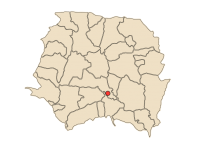The City of London
| City | |

| |
| Information | |
|---|---|
| Ruler(s): | City Council |
| Tenure: | City Council |
| Estate: | Thamesmouth |
| Sheriff: | |
| Bailiff: | |
| Heraldry | |
| Blazon: | [[London#Heraldry|]] |
| [[File:|100px]] | |
London is the first, largest, and most famous city in Britain. As all lettered men of Britain know, Prince Aeneas, a survivor of the sack of Troy, founded the Roman tribe. His great-grandson Brutus led a sea-borne
migration of Trojan exiles westward and eventually settled on this island. The natives called their land Albion, but the conquerors changed its name to Brutusland, later corrupted to Britain.
Brutus built the city Troia Nova, or New Troy (later Trinovantes), as his capital. According to Geoffrey of Monmouth, this occurred at the same time that “the priest Eli was ruling in Judea and the Ark of the Covenant was captured by the Philistines” — i.e., sometime between 1115 and 1075 BC.
A thousand years later, shortly before the coming of Julius Caesar, King Lud fortified the city and changed its name to Kaerlud, or Fort of Lud. A century later, the Romans conquered the land; its name was corrupted to Kaerlundein, and eventually London.
To the native Cymric city the Romans added their own typical urban buildings: a legionary camp, basilica, coliseum, baths, and temples. They also built the famous London Bridge, which is the only bridge that spans the navigable parts of the Thames River. Two castles help to protect London. At the west end is the Castle Lud, built over the old site of Kaerlud.
At the eastern edge of the city is the White Tower, origand castle serve as a royal residence and as refuge of last resort in times of war or uprising. London is large and influential enough to be a political power in its own right. It is run by a city senate that determines internal affairs, such as judging its citizens in the city court rather than a king’s or nobleman’s court. The senate appoints leaders, called praetors, for specific tasks.
London rules over its surrounding countryside, the County of London, and also has its own permanent garrison, which also serves as night watch, police, and firemen. Although adequate for manning the walls, though, this standing army of footmen is inferior in the field.
Since London has no expansionist ambitions, its relatively small military force has usually proved sufficient.
City gates are large, doublewide doors with towers beside them and defense works above and around. They are closed and barred every night at sundown, not to be opened for anyone or anything. Near most of the gates are small postern gates, more easily defended, where people can sometimes come in after dark, and sometimes squeeze their horses in as well.
The gates all have a market on the inside of the wall. Most of these cater to the daily needs of the local people, including the buying of excess crops in the fall. The market at Watergate is the international market, where the luxury goods are sold.
Places of Interest
- Aldgate: The gate for the road leading to Colchester (Camulodunum).
- Aldersgate: Another gate. Basilica: A cluster of buildings where the city senate meets. The formerly pagan temple is now a church.
- Lud’s Castle: The second castle of London.
- Belinsgate: This gate is named after King Belinus, whose cremated remains in a golden urn are cemented into the arch of this gate.
- Bishopsgate: When King Lucius adopted Christianity in 166, his flamens (Latin for “priest,” i.e., druids) became bishops and the archflamens (archdruids) became archbishops. Ever since then, the Bishop of London has had his residence over this gate.
- Bridge: The famous London Bridge, made of stone, with nineteen arches under which ships can sail. Cripplegate: Northern gate.
- Ludgate: King Lud, who built the first walls, reigned before the Romans came. When he died, he was buried under this gate.
- Moorgate: The northern gate got its name from the marshy moors beyond it, not from the African Moors.